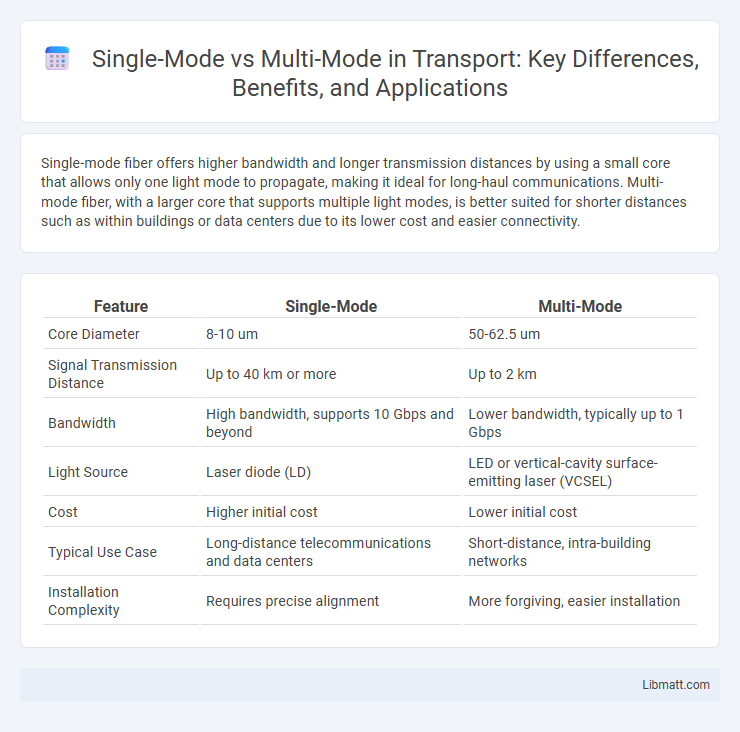Single-mode fiber offers higher bandwidth and longer transmission distances by using a small core that allows only one light mode to propagate, making it ideal for long-haul communications. Multi-mode fiber, with a larger core that supports multiple light modes, is better suited for shorter distances such as within buildings or data centers due to its lower cost and easier connectivity.
Table of Comparison
| Feature | Single-Mode | Multi-Mode |
|---|---|---|
| Core Diameter | 8-10 um | 50-62.5 um |
| Signal Transmission Distance | Up to 40 km or more | Up to 2 km |
| Bandwidth | High bandwidth, supports 10 Gbps and beyond | Lower bandwidth, typically up to 1 Gbps |
| Light Source | Laser diode (LD) | LED or vertical-cavity surface-emitting laser (VCSEL) |
| Cost | Higher initial cost | Lower initial cost |
| Typical Use Case | Long-distance telecommunications and data centers | Short-distance, intra-building networks |
| Installation Complexity | Requires precise alignment | More forgiving, easier installation |
Introduction to Optical Fiber Modes
Single-mode optical fibers transmit infrared laser light (wavelengths 1310 or 1550 nm) through a single light path, minimizing dispersion for long-distance, high-bandwidth communication. Multi-mode fibers use LEDs and transmit multiple light paths simultaneously at wavelengths of 850 or 1300 nm, suitable for shorter distances due to modal dispersion. The core diameter in single-mode fibers is typically around 8-10 microns, whereas multi-mode fibers have larger cores of 50 or 62.5 microns to support multiple propagation modes.
What is Single-Mode Fiber?
Single-mode fiber is an optical fiber designed to carry light signals over long distances with minimal loss and high bandwidth using a single light mode. Its small core diameter, typically around 8-10 microns, allows light to propagate straight down the fiber, reducing signal attenuation and dispersion. You benefit from single-mode fiber in applications requiring high-speed data transmission, such as telecommunications and internet backbone networks.
What is Multi-Mode Fiber?
Multi-mode fiber is an optical fiber designed to carry multiple light modes or rays simultaneously, allowing the transmission of data over shorter distances typically up to 2 kilometers. It features a larger core diameter, usually 50 or 62.5 microns, which enables multiple light paths but results in modal dispersion that limits bandwidth and distance compared to single-mode fiber. Commonly used in data centers and LANs, multi-mode fiber supports high-speed data communication with cost-effective transceivers.
Key Differences: Single-Mode vs Multi-Mode
Single-mode fiber uses a small core diameter, typically around 8-10 microns, allowing a single light mode to propagate, resulting in lower attenuation and higher bandwidth over long distances, often exceeding 40 kilometers. Multi-mode fiber has a larger core diameter, usually 50 or 62.5 microns, enabling multiple light modes to travel simultaneously, which increases modal dispersion and limits effective transmission distances to around 550 meters for typical Ethernet applications. The cost of single-mode fiber and associated laser sources tends to be higher, but it is ideal for telecom and long-haul networks, while multi-mode fiber with LED or VCSEL sources is more economical and suited for short-range data center and LAN environments.
Transmission Distance Comparison
Single-mode fiber optic cables support transmission distances exceeding 40 kilometers due to their smaller core diameter, which reduces modal dispersion and signal attenuation. Multi-mode fibers typically transmit efficiently up to 2 kilometers, with higher attenuation and modal dispersion limiting their range. Choosing single-mode fiber is essential for long-distance data communication, while multi-mode fiber suits shorter, cost-sensitive applications.
Bandwidth and Data Rate Capabilities
Single-mode fiber offers higher bandwidth and supports longer transmission distances due to its smaller core diameter, which minimizes modal dispersion and allows data rates exceeding 100 Gbps over tens of kilometers. Multi-mode fiber, with a larger core diameter, supports shorter distances and lower bandwidth, typically up to 10 Gbps over 300-600 meters, making it suitable for building and campus networks. The choice between single-mode and multi-mode fibers depends on required data rate capabilities and transmission distance needs.
Use Cases for Single-Mode Fibers
Single-mode fibers are ideal for long-distance telecommunications and high-speed data transmission, supporting distances up to 40 kilometers or more without signal degradation. They are commonly used in metro-area networks, cable TV networks, and undersea cable systems due to their low attenuation and minimal modal dispersion. Your network will benefit from single-mode fibers when requiring high bandwidth over extended spans, especially in enterprise or carrier-grade infrastructures.
Use Cases for Multi-Mode Fibers
Multi-mode fibers are ideal for short-distance data transmission in environments such as data centers, local area networks (LANs), and enterprise buildings where high bandwidth over distances up to 2 kilometers is required. Their larger core diameter allows multiple light modes to propagate, making them suitable for cost-effective connections using LED or VCSEL sources. Your network benefits from multi-mode fibers when flexibility and lower equipment costs outweigh the need for long-haul or high-capacity transmission.
Cost Analysis: Single-Mode vs Multi-Mode
Single-mode fiber optics typically incur higher initial costs due to more expensive lasers and transceivers but offer lower maintenance and longer-distance transmission benefits, reducing total cost of ownership in large-scale or future-proof networks. Multi-mode fiber systems are generally more cost-effective upfront with cheaper light sources like LEDs and less expensive connectors, suitable for short-distance applications such as data centers. Evaluating cost analysis requires balancing initial equipment expenses, network scale, distance requirements, and long-term operational efficiency when choosing between single-mode and multi-mode fiber.
Choosing the Right Fiber for Your Application
Selecting the right fiber optic cable depends on distance and bandwidth requirements; single-mode fiber offers long-distance transmission with higher bandwidth using a laser light source, ideal for telecommunications and large-scale networks. Multi-mode fiber supports shorter distances with lower bandwidth, utilizing LED light sources, making it cost-effective for local area networks and data centers. Evaluating factors such as installation cost, distance, and data rate is crucial for optimizing network performance and ensuring future scalability.
single-mode vs multi-mode Infographic

 libmatt.com
libmatt.com